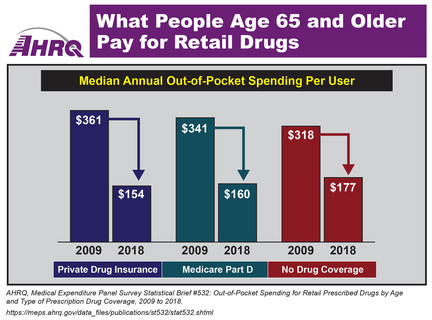| March 9, 2021, Issue #754  Access more data on this topic in the associated statistical brief.  An AHRQ analysis of three hypothetical COVID-19 vaccine distribution plans showed that different prioritization schemes may lead to different trajectories of eligibility across population subgroups. In their analysis of data from AHRQ's Medical Expenditure Panel Survey, agency researchers found that distributing the vaccine by age would simplify the process but slow vaccine eligibility across poverty levels and across race and ethnicity for key population subgroups. An alternative approach that granted relatively high priority to most essential workers and adults age 65 and older would result in quicker vaccine eligibility among adults in higher-income families and White adults than among adults living in poverty or racial and ethnic minorities. In another scenario, prioritizing adults at increased risk of severe COVID-19 ahead of non-healthcare high-priority occupation groups would increase access to the vaccine among Black adults and adults living in poverty, but would delay eligibility of some workers who have increased risk of exposure and increased risk of transmission to others. | While updated cholesterol guidelines recommended that more people in the United States would benefit from taking statins, the new guidelines resulted in only a nearly 2 percent increase in the use of statins to prevent and treat cardiovascular disease, according to an AHRQ-funded study published in the Journal of the American Board of Family Medicine. Patients at the highest risk of cardiovascular disease did not increase their statin use any more than patients in lower risk categories. Twenty-four clinicians and practice leaders interviewed reported that multiple factors impacted whether patients who could benefit from statins were receiving them. Some patients may have been influenced to resist updated guidelines by advertisements and the experiences others had with statins. Clinicians also expressed frustration with frequent changes to guidelines. Study authors suggested future guidelines may best focus on high-risk patients most likely to benefit. Access the abstract.  Wearable consumer devices and mobile apps that collect health data such as heart rate and blood pressure might help patients control coronary artery disease, heart failure and asthma, according to an AHRQ evidence review. Evidence also indicated the devices shortened cardiac arrhythmia detection time and improved blood pressure, but there was no direct evidence of the impact on health outcomes for these two conditions. These technologies are not effective for addressing obesity, and evidence was unclear for seven other chronic conditions. Researchers evaluated the use of 118 devices and 26 mobile apps for prevention or treatment of 11 chronic conditions. They looked for evidence on the devices' impact on health outcomes such as mortality, quality of life and symptom improvement. While possible positive effects were found for coronary artery disease, heart failure and asthma, impacts were unclear on obesity, and evidence showed a lack of effect on weight. The other five conditions studied were chronic obstructive pulmonary disease, diabetes prevention, sleep apnea, stroke and Parkinson's disease. Access the Technical Brief. | - On March 16 from 1 to 2 p.m. ET, the Institute for Healthcare Improvement (IHI) will sponsor a webinar on "Workplace Violence: Protecting Healthcare Workers." Jeff Brady, M.D., M.P.H., director of AHRQ's Center for Quality Improvement and Patient Safety, and Patricia A. McGaffigan, R.N., M.S., IHI's vice president, safety programs, will co-moderate a panel featuring leaders who have helped their organizations and communities to prevent and reduce workplace violence. The webinar—intended for healthcare executives, safety and quality leaders, and those who provide direct care—will highlight tools and approaches that can help prevent and reduce violence in healthcare settings. Register.
- On March 17 from 1 to 2:30 p.m. ET, a webinar hosted by AHRQ, the Health Resources and Services Administration and other federal partners will highlight the potential of high-reliability organizations to increase patient safety. High-reliability organizations sustain safe practices and avoid failures despite operating in hazardous conditions and complex environments. Kathleen M. Sutcliffe, Ph.D., a Bloomberg Distinguished Professor at Johns Hopkins University, will cover the fundamentals of high reliability, helping healthcare organizations learn how they can operationalize these concepts and become high-reliability organizations. Register.
A new online data tool from AHRQ allows users to explore state- and age-specific rates of emergency department visits related to suicide ideation and suicide attempts. The tool is among several interactive data visualizations that support the agency's ongoing efforts to make data readily available to researchers, policymakers and other stakeholders. Previous data visualizations allow users to explore data related to health insurance cost sharing, characteristics and costs of potentially preventable hospital stays, the impacts and causes of traumatic brain injuries and trends in opioid-related hospitalizations. The newest tool is based on a statistical brief from AHRQ's Healthcare Cost and Utilization Project. AHRQ's Patient Safety Network (PSNet) highlights journal articles, books and tools related to patient safety. Articles featured this week include: Review additional new publications in PSNet's current issue or access recent cases and commentaries in AHRQ's WebM&M (Morbidity and Mortality Rounds on the Web). | AHRQ in the Professional Literature Parent perspectives on pediatric inpatient OpenNotes. Smith CA, Coller RJ, Dean SM, et al. AMIA Annu Symp Proc. 2020 Mar 4;2019:812-9. Access the abstract on PubMed®. Healthy People 2030 health literacy definition tells organizations: make information and services easy to find, understand, and use. Brach C, Harris LM. J Gen Intern Med. 2021 Jan 22. [Epub ahead of print.] Access the abstract on PubMed®. Examining urban and rural differences in how distance to care influences the initiation and completion of treatment among insured cervical cancer patients. Spees LP, Brewster WR, Varia MA, et al. Cancer Epidemiol Biomarkers Prev. 2019 May;28(5):882-9. Epub 2019 Feb 7. Access the abstract on PubMed®. Ensuring sustainability of needed antibiotics: aiming for the DART Board. Spellberg B, Nielsen TB, Gilbert DN, et al. Ann Intern Med. 2019 Oct 15;171(8):580-2. Epub 2019 Oct 8. Access the abstract on PubMed®. Receipt of social needs assistance and health center patient experience of care. Nguyen KH, Trivedi AN, Cole MB. Am J Prev Med. 2021 Mar;60(3):e139-e47. Epub 2020 Dec 11. Access the abstract on PubMed®. Association of breast cancer surgery with quality of life and psychosocial well-being in young breast cancer survivors. Rosenberg SM, Dominici LS, Gelber S, et al. JAMA Surg. 2020 Nov;155(11):1035-42. Access the abstract on PubMed®. Variations in surgical spending within hospital systems for complex cancer surgery. Diaz A, Chhabra KR, Dimick JB, et al. Cancer. 2021 Feb 15;127(4):586-97. Epub 2020 Nov 3. Access the abstract on PubMed®. Provider networks and health plan premium variation. Polsky D, Wu B. Health Serv Res. 2021 Feb;56(1):16-24. Epub 2020 Aug 13. Access the abstract on PubMed®. Contact Information For comments or questions about AHRQ News Now, contact Bruce Seeman, (301) 427-1998 or Bruce.Seeman@ahrq.hhs.gov. |





No comments:
Post a Comment